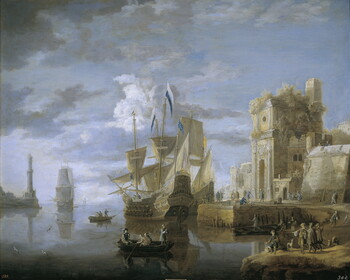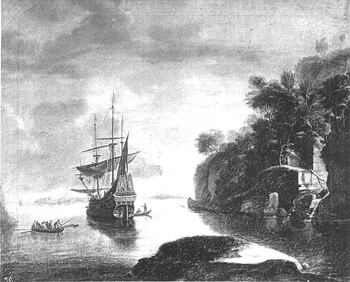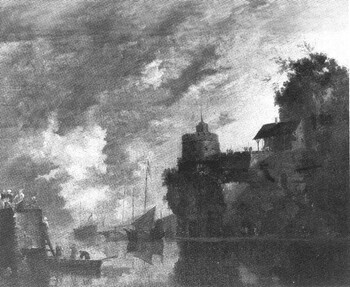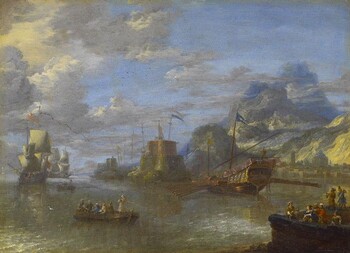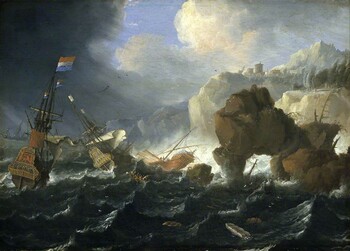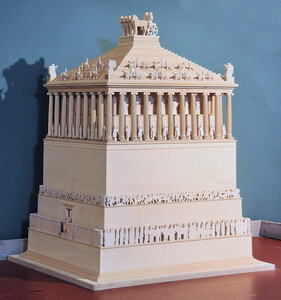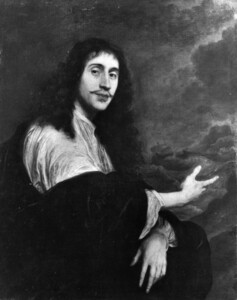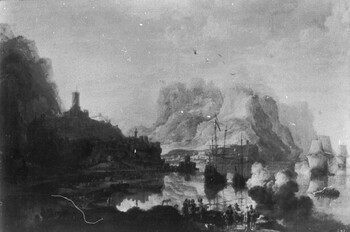10.700 €
In short
Jan Peeters I belonged to an important Antwerp family of marine painters. He studied under his famous brother, Bonaventura I Peeters.
Jan must have travelled extensively in the Eastern Mediterranean. Our painting represents an exotic bay with Turkish figures. The building on the hill at right must be the famous Mausoleum in Halicarnassus (today's Bodrum), the 4th century BC tomb of Mausolus, one of the Seven Wonders of the Ancient World. It was topped with a chariot sculpture.
About Jan Peeters I
Flemish painter
Antwerp 1624 – 1677 or 1680 Antwerp
Marine and landscape painter.
Member of an important family of painters, most of them of maritime subjects. Best known is Jan ‘s brother, Bonaventura I.
Jan I was the younger brother and pupil of Bonaventura I (1614 – 1652), their elder brother was Gillis I (1612 – 1653).
Our painter, Jan Peeters I, became Master in the Painter’s Guild of Saint Luke in Antwerp in 1645. Nine years later he got married in Antwerp in 1654. In 1659 he spent six months in Holland designing panoramic depictions of several towns and harbours that were later engraved by Gaspard Bouttats.
Besides domestic marine scenes Jan I also painted a lot of Mediterranean scenes. He must have travelled extensively in the Eastern Mediterranean. Jan was also an important draughtsman, whose topographic views were engraved. Several series of engravings with views of Turkish, Greek, Egyptian and North African harbour towns are known. The University of Liège in Belgium holds a set of six engravings after designs by Jan Peeters with views of Crete: “Insula di Candia del Mare Mediteranea”. They were published in Antwerp at the end of the 17th century. The frontispiece was engraved by Coenrard Lauwers (1632 – 1685), the five town views by Lucas Vorsterman (Zaltbommel 1595 – 1675 Antwerpen): two of Chania, one of Rethymnon and two of Souda.
Jan I is best known for his rough seas with shipwrecks, but he was equally experienced at rendering calm waters. His style is meticulous. He was a skilled painter of atmospheric conditions, especially of clouds. Occasionally he painted winter scenes and town views.
About the other painters of the Peeters family
- Bonaventura I was one of the most important 17th century Flemish marine painters; he painted both domestic Flemish and Dutch waters, and exotic, Turkish subjects (referring to the Eastern Mediterranean, but possibly also to the coasts of Northern Africa).
It is generally accepted that Bonaventura I Peeters could not have travelled in the Mediterranean: he painted decorative, poetic interpretations of engravings, drawings and paintings of other artists, not realistic views of regions that he travelled to.
He died at the age of 38, unmarried, suffering the last years of his life from an ill health. He lived in Hoboken, just South of Antwerp on the river Scheldt, together with his sister Catharina and possibly with his younger brother, our Jan I.
- Gillis I travelled to South America, visiting the Dutch colonies and making topographical landscapes; based on his accounts Bonaventura I also painted a few “Brazilian” coasts. He also painted landscapes.
- Catharina (1615 – after 1676), their sister, must also have painted marine paintings.
Gillis I had two sons who also became painters.
Bonaventura II (1641 – 1702) was a pupil of Bonaventura I. His landscapes show the influence of his father, his seascapes betray the impact of his uncle. Most of his Turkish subjects have until recently been wrongly attributed to his uncle, Bonaventura I.
Of Gillis II (1645 – 1678) there is only one signed and dated landscape known. He died in a convent in present-day Indonesia, then a Dutch colony, at the age of 33.
Of his third son, Willem, nothing is known.
As to our Jan Peeters I he had two children who studied painting under him, but who are further unknown: his son Jan Frans and his daughter Isabella Josina.
The famous still life painter Clara Peeters was not related to this branch of the Peeters, nor was the painter of architectural scenes Jacob Peeters.
About our painting
On the top of a high hill right of the centre stands a large monument. That must represent the Mausoleum of Mausolus in Halicarnassus (present-day Bodrum in Turkey). Our painter must have been inspired by its description by the famous Roman author Pliny the Elder (23 – 79 AD): the monument was almost square, with a total periphery of 125 metres. It was bounded by 36 columns, and the top formed a 24-step pyramid surmounted by a four-horse marble chariot.
The monument must have been destroyed by an earthquake between the 11th and the 15th century. Its stones were reused in local buildings, especially in the construction of the Castle of Bodrum. The British Museum in London holds several monumental statues (best-known are the pair of colossal statues traditionally identified as Mausolus and his wife Artemisia II) and a series of bas-reliefs from its frieze.
Why should you buy this painting?
Because our Ottoman beach scene, painted in fragile pastel shades, holds a Classical Greek surprise for Peeters’ s and for my well-read clients.

